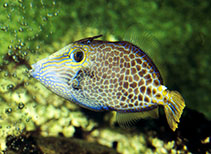| Family: |
Monacanthidae (Filefishes) |
| Max. size: |
25 cm TL (male/unsexed) |
| Environment: |
reef-associated; marine; depth range 0 - 20 m |
| Distribution: |
Indo-Pacific: Red Sea south to South Africa (Ref. 4421) and east to southern Japan and southeastern Oceania. Eastern Atlantic: Gulf of Guinea, Annobon Islands, south coast of Africa (Ref. 3592). Replaced by Cantherhines sandwichiensis in the Hawaiian Islands (Ref. 37816). |
| Diagnosis: |
Dorsal spines (total): 2-2; Dorsal soft rays (total): 32-36; Anal spines: 0-0; Anal soft rays: 29-32. Can adopt three basic color patterns: mottled grey and brown, dark brown, or grey with a network of close-set polygonal spots. All have a small white spot at the rear base of the second dorsal fin and sometimes the anal fin.
Description: Characterized further by first dorsal spine nearly equal to length of snout, above front half of eye and partially fitting into groove on back; side of caudal peduncle with dense patch of setae in adult male; concave dorsal profile of snout; rounded caudal fin; depth of body at origin of anal fin 2.1-2.3 in SL (Ref. 90102). |
| Biology: |
Occurs on outer reef slopes to depths of 2 to more than 20 m (Ref. 1602, 48637), often silty habitats. Young float with loose surface weeds and adults are often with large Sargassum rafts during the wet season (Ref. 48637). Solitary. Feeds on benthic organisms (Ref. 30573). Somewhat secretive (Ref. 9710). Minimum depth reported taken from Ref. 128797. |
| IUCN Red List Status: |
Least Concern (LC); Date assessed: 02 March 2015 Ref. (130435)
|
| Threat to humans: |
harmless |
Source and more info: www.fishbase.org. For personal, classroom, and other internal use only. Not for publication.
